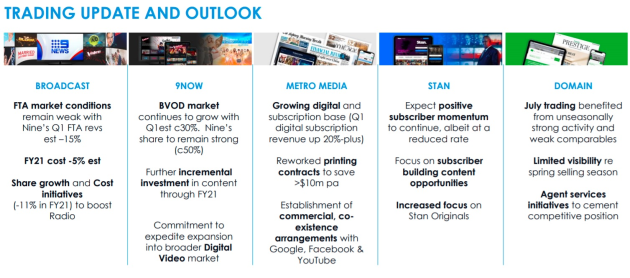
Analysts are impressed with Nine Entertainment’s full year results, its continuing shift to digital revenue and its ability to pay a dividend in the face of the economic fallout from the pandemic.
The media company posted a $508.78 million loss mainly on impairment of goodwill. Excluding special items, profit fell 17% to $155.4 million for the year to June.
But Nine’s revenue from digital business continues to rise as the fortunes of print decline.
Brian Han, senior equities analyst at Morningstar, wrote a note titled, Digital Transformation Is Nine's Vaccine Against Coronavirus.
He points out that the media group ended the 2020 financial year with wholly owned net debt of $291 million, 11% below Morningstar forecasts.
Second half EBITDA (earnings before interest, taxes, depreciation, and amortisation) was a better-than-expected $124 million, well ahead of forecasts of $107 million.
Han described “stellar working capital management” and financial strength leading to an unexpected fully franked final dividend of $0.02 a share.
This is a rare event in the coronavirus-disrupted advertising sector.
“In a reporting season where no media companies under our coverage declared any (except News Corporation), shareholders should be pleased, not just with the payout, but with the positive signalling,” Han writes in a note to clients.
Here's Nine trading update and outlook:
Digital earnings almost reached management's 2024 target of 60% of group total in the June half but that was down to shrinking profits from legacy media due to the pandemic.
However, Han says the bulk of Nine’s $230 million cost cutting program by the 2024 financial year is aimed at stripping the "old media" business cost base.
This will position Nine well when advertising recovers and the revenue mix shifts to a more subscription-based one.
“Concerted efforts to reduce the group's exposure to the traditional media space are making solid progress,” Han says.
Second half underlying EBITDA from digital centric business units -- 9Now, 9 Digital, Stan, Domain -- grew 1% to $73 million, partly mitigating the 53% fall from advertising-led businesses -- free-to-air TV, metro media, radio -- to $51 million.
Investment bank Jefferies says the free-to-air guidance for the September quarter, down 15%, appears disappointing but the timing of major sporting events -- State of Origin and the NRL Grand Final -- have been shifted to the December quarter.
The Jefferies analysts say Nine continues to invest in good content to fend off competition from Seven West Media (SWM).
“In BVOD, SWM is catching up but NEC has better data to match user profiles, which advertisers pay a premium for,” the analysts say.
Nine’s metro media division will be less reliant on advertising and digital subscription.
And then there’s the potential revenue from digital platforms via the federal government’s mandatory code.
And the company has the capacity for acquisitions.
“Given its solid balance sheet, NEC is well-placed to make further acquisitions especially in regional areas where it is still under-represented,” say the Jefferies analysts. “NEC's management is known for its ability to extract revenue and cost synergies.”
The analysts say the ad market continues to be challenging but it is ahead of earlier expectations.
A slide from Nine's full year results presentation:
Have something to say on this? Share your views in the comments section below. Or if you have a news story or tip-off, drop us a line at adnews@yaffa.com.au
Sign up to the AdNews newsletter, like us on Facebook or follow us on Twitter for breaking stories and campaigns throughout the day.




